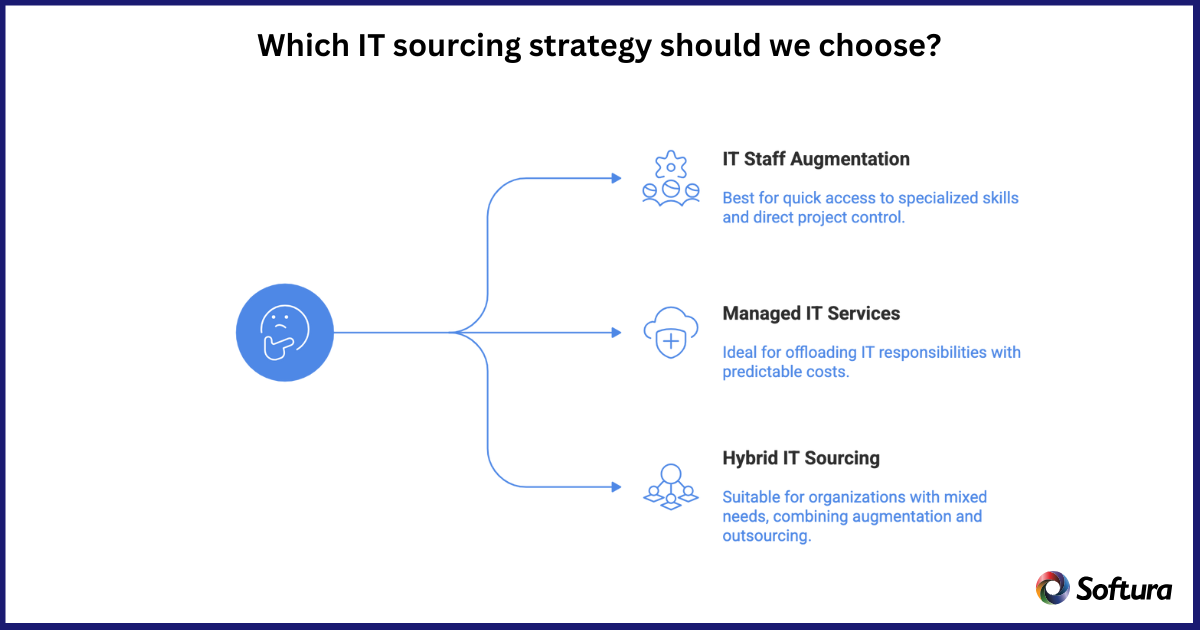"Our integration with the Google Nest smart thermostats through Aidoo Pro represents an unprecedented leap forward for our industry."
- Antonio Mediato, founder and CEO of Airzone.

If you’re pressed for time, here’s the short version:
This quick decision matrix helps executives choose the right model without wading through unnecessary detail.
The defining difference, from Softura’s perspective, is who holds the steering wheel.
With IT staff augmentation, external experts act as extensions of your existing teams. They adopt your processes, tools, and standards. The client retains control but also carries accountability if delivery falters. We often describe this as “renting talent without giving up the driver’s seat.”
With managed services, the provider assumes end-to-end accountability. They commit to outcomes defined by SLAs—such as uptime, ticket resolution, and application reliability—while your team shifts from daily management to strategic oversight. The choice between staff augmentation and managed services depends on your goals, budget, and needs. (If you’re also considering fully outsourcing development, our staff augmentation vs outsourcing guide details how handing off an entire project compares to augmenting your team.)
Rapid access to talent with onboarding in 1–3 days compared to 41–82 days when hiring internally.
Direct control over work prioritization, tools, and outcomes.
Flexibility to scale up or down quickly.
Ability to select niche or highly specialized roles for short bursts of work.
Requires management bandwidth from your leadership team.
Delivery success depends heavily on your internal governance.
Accountability for outcomes stays with you.
Risk of cultural misalignment if external staff do not integrate smoothly.
Provider owns delivery responsibility.
Predictable performance under contractual SLAs.
Less operational burden on your managers.
Often includes standardized processes, best practices, and automation capabilities.
Less agility when business priorities change midstream.
Possible erosion of internal technical expertise.
Dependency on vendor capabilities with potential lock-in risk.
May limit opportunities for internal team learning and innovation.
"Our integration with the Google Nest smart thermostats through Aidoo Pro represents an unprecedented leap forward for our industry."
- Antonio Mediato, founder and CEO of Airzone.
How you pay reflects how risk is distributed between you and your vendor.
Real-World Example: A manufacturing client facing a seasonal production surge used staff augmentation to add developers for ERP enhancements, funded on a T&M basis. After stabilization, they shifted to a managed services retainer for maintenance to control long-term costs. This mix allowed them to benefit from short-term agility while ensuring predictable expenses.
"By analyzing the data from our connected lights, devices and systems, our goal is to create additional value for our customers through data-enabled services that unlock new capabilities and experiences."
- Harsh Chitale, leader of Philips Lighting’s Professional Business.
Success looks very different in each model.
Deeper Insight: In practice, staff augmentation is about measuring inputs and team productivity. Managed services measure outputs and delivered outcomes. Understanding this distinction is crucial when executives report performance to the board. Boards care about cost per outcome, while engineering teams often care about cycle time and velocity. Aligning KPIs to stakeholders ensures that neither model is unfairly judged.
Scale Skills Without Losing Control
Staff augmentation lets you add niche expertise in days while retaining full project oversight and governance.
This is where many enterprises underestimate the stakes.
From Softura’s perspective, the principle is simple: you can outsource execution, but not accountability. Regulators and clients still expect you to remain responsible for compliance and security.
Most organizations don’t stick to one model permanently. The right approach evolves with growth, regulation, and digital priorities.
Softura’s Perspective: We advise our clients not to treat this decision as a binary choice. We recommend approaching sourcing models as a portfolio, balancing agility, cost, and compliance across functions. In practice, we help organizations revisit this portfolio every 12–18 months based on talent availability, budget pressures, and shifting technology priorities. For leaders exploring blended approaches, our related insights on Hybrid Models: Co-Sourcing with IT Staff Augmentation and Software Outsourcing show how a combined strategy often delivers the best balance between control, cost, and accountability.
Both IT staff augmentation and managed services address real and pressing challenges — the difference lies in alignment.
Final Executive Takeaway:
Choosing between these models is not just an operational decision — it’s a strategic one. CIOs and CFOs must weigh cost predictability against agility. CTOs must balance innovation speed against knowledge retention. Boards must evaluate compliance exposure against operational stability.
At Softura, we’ve observed that the most successful organizations don’t lock themselves into a single model. Instead, they monitor operational signals, assess governance requirements, and evolve their sourcing strategy as business priorities change. The real advantage lies in knowing when to scale talent, when to outsource, and when to blend both for maximum impact.
Stabilize Operations With Managed Services
Shift outcomes and SLAs to trusted partners for predictable costs, reliable uptime, and reduced leadership burden.